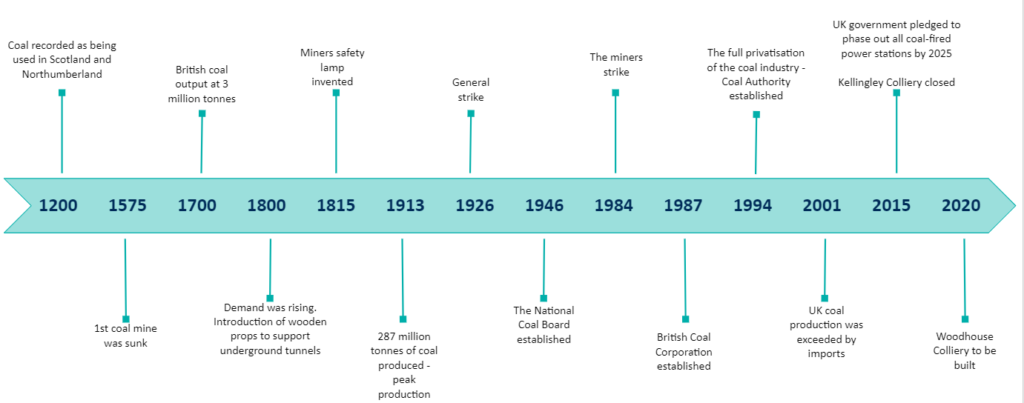The coal mining legacy lives on

The story starts around 360 million years ago in the Carboniferous period when dead plant matter in former wetlands, now known also as coal forests, decayed, accumulating enormous deposits of peat, which over time, changed to coal.
Fast forward to 12,000 years ago and we see the earliest evidence of coal extraction, but it wasn’t until the 13th century that coal began to be used on a wider scale.
Off the shores of Northumberland and Scotland, ‘Sea coal’ as it was called, washed up on local beaches, and due to their strategic coastal locations, we began shipping the coal around the UK.
In 1575 the first (under the sea) coal mine was sunk beneath the Firth of Forth, and by 1700 British coal output stood at around 3 million tonnes. As a result of the Industrial Revolution, Britain’s coal output was increasing to meet the demand for fuel to power steam engines.
Up until the late nineteenth-century coal was mined underground using a pick and shovel, facilitated by Sir Humphry Davy’s invention of the miners’ safety lamp in 1815. The method of surface mining was introduced in 1912 and Britain’s coal output hit its maximum peak of 287 million tonnes.
The coal industry then had its many ups and downs: it was ravaged by strikes; then nationalisation; and subsequent privatisation; until around 2001 when UK coal production was actually exceeded by imports. There was then a steady decline in the demand and use for coal as globally, environmental issues began to take precedence. In 2015 the UK government pledged to phase out all coal-fired power stations by 2025 and today we see only four remaining.

At midnight on the 9th April 2020, the last coal generator came offline, and Britain has gone more than two months without burning coal for electricity. This is the longest period since the dawn of the Industrial Revolution. Whilst partly this is due to demand for electricity plummeting when Britain went into COVID-19 lockdown on the 23rd March, but also thanks to the huge investment in renewable energy over the last decade.
Over the years Groundsure has been involved in assessing and advising on tens of thousands of hectares of former colliery land. The issues associated with these assets are multiple and range from ground stability and mining legacy issues such as shafts and related features through to contaminated land and widespread detrimental impacts on surface and groundwater resources.
Groundsure continues to develop and grow its data sets that cover the issues thrown up by the legacy of coal (and other mining). Groundsure acquired Mining Searches UK in January this year to further bolster its capability in the mining arena following the launch of the Groundsure CON29M report in 2019. The combined business now offers the most comprehensive coverage of mining and environmental information that can aid land and property transactions across the UK. Click here for more information about the in-depth CON29M report (which includes a mine entry interpretive assessment AND a Cheshire Salt search alert, as standard, where applicable).
Finally, look out for exciting news about our new full mining solution GeoRisk which launches in September. Email marketing@groundsure.com for more information.
Date:
Aug 3, 2020
Author:
Catherine Shiers

